The birth of the United States of America was anything but peaceful. Two major wars were necessary so that the nation as we know it today could emerge: the Mexican-American War and the American Civil War.
Where the dollar sign comes from
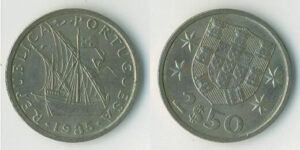
Until today, the most common explanation for the origin of the dollar sign $ is the following: The sign $ is the result of a contraction of the words “pieces of eight” that evolved through several intermediate stages to “P8” and eventually to “$”. Another theory claims that the letters U and S of “United States” were superimposed. Advocates of the “column theory” are of the opinion that the sign $ stems from the design of the piastre that depicts the two Pillars of Hercules, which have represented the Rock of Gibraltar since ancient times. The latest research leads to this conclusion: $ evolved from the cifrão, a sign used in the Portuguese language to distinguish amounts of money in escudos and in centavos – thus, 2 $50 means “2 escudos and 50 centavos”.
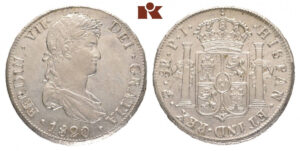
That is to say, the origin of the dollar sign is a matter of dispute. It is certain, however, that the dollar itself stems from the Spanish “peso de a ocho” – the coin that was minted in huge quantities in the Spanish colonies during the 18th century. A major part of these so-called pillar dollars circulated on the American continent, where the developing economy required more and more financial means. The name “pillar dollar” refers, one the one hand, to the design of the coin, and on the other hand, to the German word “Taler”. The name “dollar” thus stems from a German word while the coin itself is a descendant of the Spanish peso.
A national currency
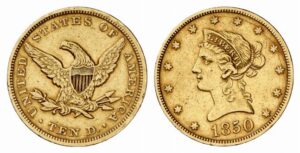
After the American Revolutionary War (1775-1783), the United States Congress faced the task of creating a national currency. Until then, mainly Spanish and Mexican silver coins had been used as means of payment in America – besides the paper money that had been issued by the single colonies since the end of the 17th century already. However, the paper money was only valid within the respective colony, and therefore it could only be used in the regional market.
After time-consuming discussions, the Congress decided to use the peso as base-unit of denomination and to name it “dollar”. So-called “eagles” of 10 dollars were to be minted in gold as well as “half eagles” of 5 dollars and “quarter eagles” of 2.5 dollars. In addition to the half dollar and the quarter dollar, dismes and half dismes made of silver were to be produced. Moreover, copper coins of 1 cent and – the coin type of the lowest denomination – “half cents” were minted. 200 of the latter were needed to make a dollar. Apart from this exception, the new American currency was based on the decimal system. The peso continued to be legal tender in circulation.

Even if half cent coins were minted for a long period of time, they were an unpopular denomination. Around 1800, a half cent had a rather high purchasing power because one dollar had still a considerable value. However, the half cent coin had a smell of poverty: It was associated with neediness and considered to be the coin of the poor.
In Congress, the design of the copper coins was a controversial issue. The question whether the obverse of the small denomination should feature the portrait of the president or a personification of freedom was the subject of fierce debate. Finally, they opted for freedom and thus for Lady Liberty as a symbol of the republic. This was a deliberate contrast to the coins of monarchies featuring the portrait of the king or queen.

The Mexican-American War
In 1812, at a time when Mexico was still called New Spain, the Spanish envoy Luis de Onís reported a strange offer to his viceroy. The US government had informed him that it intended to acquire the areas of New Spain located north of the Rio Grande up to the Pacific Ocean. And in fact, in the following years, the USA offered Spain and then also Mexico, which had become an independent country, to buy its “northern territories” – the current states of California, Arizona, Nevada, Utah, New Mexico, Texas and parts of Colorado and Wyoming. However, both Spain and Mexico firmly rejected all such requests.
In the following years, the relationship between Mexico and the USA deteriorated constantly; in 1845, the war was already casting its shadow. In 1836, Texas declared its independence from Mexico and, being massively influenced by the USA, – voted for the annexation into the United States. In April 1846, the USA sprang into action: The US army occupied Mexican settlements in Texas, which had been “accepted” in the meantime as a state of the USA. A few days later, the first shots were fired against American soldiers. As a consequence, the US government under President James Knox Polk (1845-1849) declared war on Mexico.
The Mexican-American War ended in 1848 with the victory of the USA. Mexico was forced to surrender all of its territories north of the Rio Grande – an area of 1.2 million square miles – and, in return, Mexico received a compensation of 15 million dollars from the USA. Thus, the national territory of Mexico was reduced by nearly a half and the territory of the USA established more or less the shape it has today. Moreover, the power structure of the Americas shifted decisively: The USA became a global power between two oceans and, since then, they have claimed the notions of “America” and “American” for themselves.

Why was it profitable for the USA to wage war with Mexico?
At the end of the 1840s, large goldfields were discovered in California, which had become part of the USA as a result of the Mexican-American War. In the following years, gold worth 600 million dollars was produced here, and this gold had to enter the trade market and had to be used. Therefore, the United States Congress decided to produce three new coins in addition to the existing ones (the eagle and its fractional values): the gold dollar, a coin of 3 dollars and the double eagle worth 20 dollars.
The first 1 dollar piece made of gold
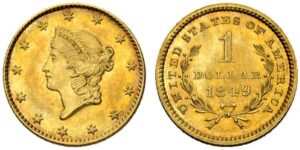
The first gold dollar was minted in 1849; it was a tiny coin measuring a diameter of only 13 mm and weighing less than 2 grams. It is the smallest coin that ever entered circulation in the United States. And that is the reason why the Americans were not happy about this coin: Coins this small are easy to lose, and, after all, one dollar still had a considerable value around the middle of the 19th century, for many workers it was more than their daily wage.
In contrast to the copper coins, the Congress agreed right from the beginning on the design of the silver and gold coins: A symbol of freedom was to be depicted on the obverse and on the reverse an eagle, a return to antiquity. In Roman times, the eagle was considered to be the symbol of the highest secular power and therefore it could be found on the standards of the Roman legions. However, on the tiny first gold dollar coins was no room to depict an impressive eagle – that is why they only featured a simple value mark. The obverse was designed according to the instructions of the Congress and showed Lady Liberty surrounded by 13 stars representing the 13 founding states of the USA.
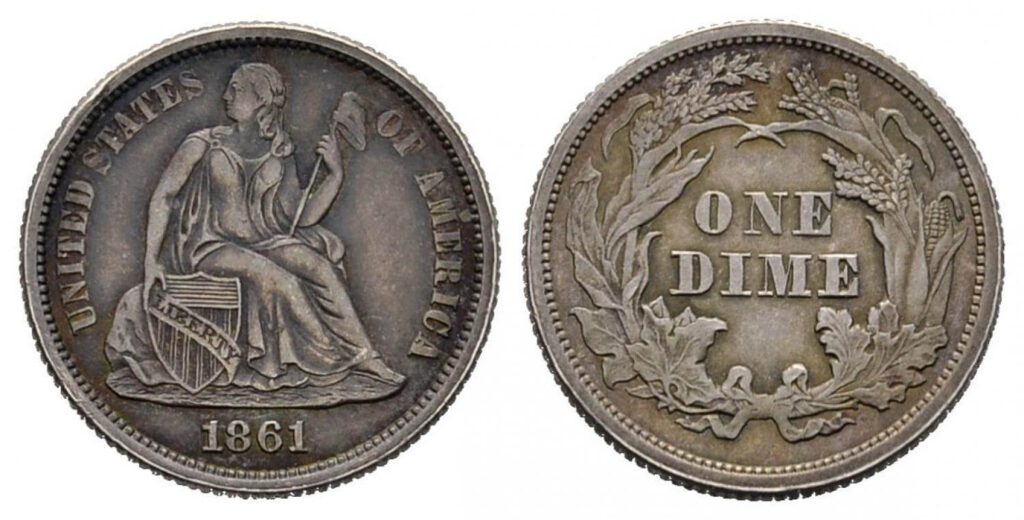
A matter of small change
Around the middle of the 19th century, there was a pressing lack of small change in the USA. Of course, different small coins were minted: In addition to the cent and the half cent, there were half dollars and quarter dollars made of silver, and dismes and half dismes. The name “dime” is a simplification of the original name “disme” and originates from the French “décime”, meaning “tenth part”. Therefore, the lack of small change was not the result of the fact that not enough coins were minted – the American coins had a different problem: they were too precious! They contained a lot of precious metals and therefore they immediately disappeared abroad, where they were melted down in order to sell the silver at a higher price. Only the oldest Spanish pesos remained in circulation in the USA: The mintage of the dollar coin was stopped as early as in 1806. Why should a coin be minted that immediately disappeared from circulation anyway?
In 1853, the United States Congress decided to put an end to the lack of small change by means of a monetary reform. The silver content of the coins was reduced and thus the metal they contained was worth less than the nominal value of the coin itself. The gold coins continued to circulate with the same gold content, so that gold coins became the prevailing currency of the USA.
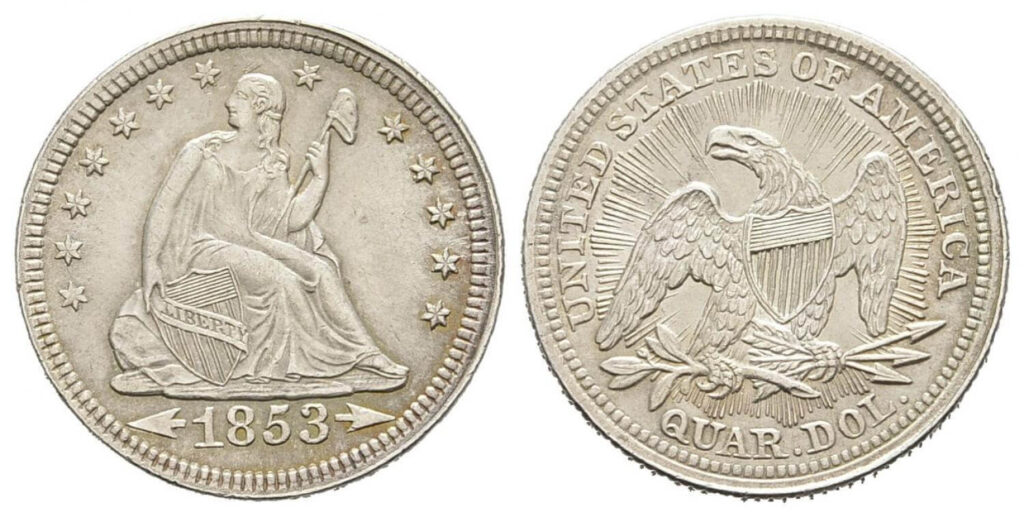
The quarter dollar on the picture features on the obverse Lady Liberty with the liberty cap and the coat of arms of the United States surrounded by 13 stars representing the 13 founding states of the USA. The reverse shows the depiction of a splendid eagle. In its claws it holds three arrows – to signal its defence capability – and an olive branch as a symbol for peace. The coat of arms of the USA is also depicted on the eagle’s chest.
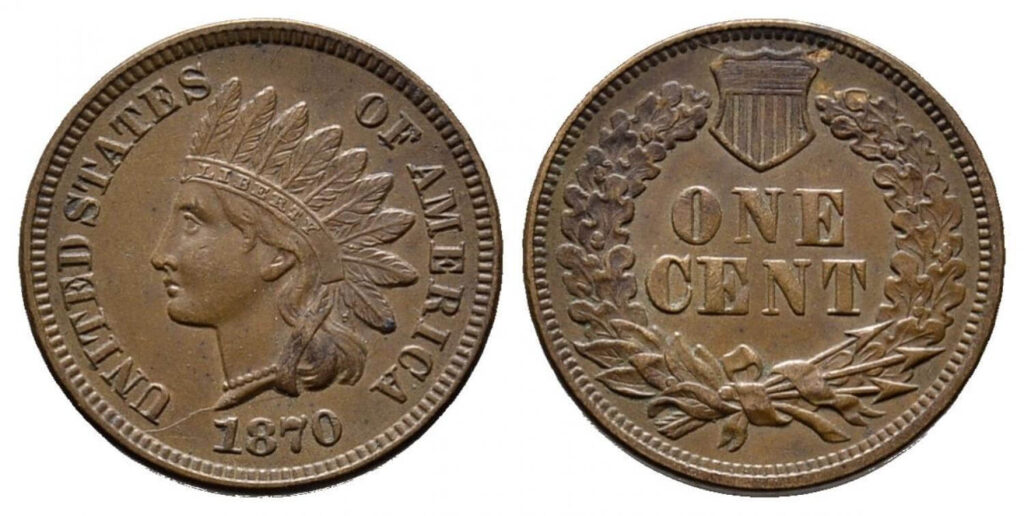
The monetary reform of 1853 resulted in an orderly silver coin circulation, and a few years later the problem of the copper coins was addressed as well. During the lack of silver money prevailing in those years, the copper coins experienced a certain upturn because change is indispensable in the daily trade.
However, in 1857 the production of small copper coins became too expensive: The value of copper had increased, and therefore the value of the metal exceeded the nominal value of the copper coins. That is why the minting of half cents was stopped. The cent itself became smaller and lighter and was now made of a mixture of copper and nickel.
The development of the West
When the independence was officially recognised in 1793, the USA covered a territory of about 2 million square kilometres. In 1848, after the end of the war against Mexico, the United States expanded their territory, which then comprised more than 7 million square kilometres. The colonisation of this huge country happened almost as fast as its acquisition. At the beginning of the 1850s, more than 400,000 emigrants from Europe arrived in North America every year.
However, until the 70s of the 18th century, the development of the inland areas only made slow progress. The first ones to enter these areas were trappers, rangers, fur traders and hunters. The inland areas became the “frontier”, the outer line of the settlement. This referred to regions in which less than six people per square mile lived. Those people were called “squatters” – wild settlers that cleared the forest and laid out fields without legal rights to the land. After a few years, when the next wave of colonists came, the squatters moved the frontier further into the inland areas. Where they had lived before, farmers settled down, founded schools and built churches; dealers, craftsmen and contractors settled down there.
The American Civil War
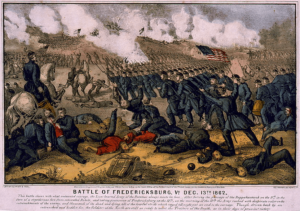
Meanwhile, the US government was discussing whether slavery should be extended to the Wild West. When Abraham Lincoln (1861-1865), a slavery opponent, was elected President of the United States in 1860, the eleven slaveholding southern states seceded from the United States and founded the Confederate States of America. This secession became an extremely bloody conflict, which – in military terms – seemed to be a foreshadowing of both world wars: For the first time in history, improvised mass armies with all their organisational, operational and psychological problems could be encountered. However, the military science of Europe only pays little attention to these experiences.
For four long years, the northern and southern states waged a bitter war, and more than 630,000 soldiers lost their lives. In the American Civil War – which lasted by the way just as long as Lincoln’s presidency – the South fought primarily for its independence and the North for the survival of the Union. In reality, however, the war was about the incompatibility of two production methods – the North was industrialised, and industrialisation requires mobility and freedom. On the other hand, the independence of the South was based on the plantation economy – and if slaves work on the plantations, this system generates the most profit. Only in 1863, emancipation became a war objective of the northern states – they hoped that this would prevent the European states from interfering in the war on the side of the South.
In 1865, the Union forced the Confederacy to surrender. This was the official end of the civil war and of slavery. What followed was the complete collapse of the southern states, which had been economically inferior to the North already at the beginning of the war. Because the people had been of the opinion that American cotton was indispensable for Great Britain and France, the southern states had hoped in vain for the support of these countries. History proved them wrong – henceforth, Europe imported more and more cotton from Colonial India and Egypt.
In the next part, you can learn about how the American Civil War resulted in the boom of one part of the USA and in the economic crisis of the other part.




